Gigabyte GA-P55M-UD2 - P55 uATX Goodness for Under $105 - Updated
by Gary Key on August 28, 2009 12:00 PM EST- Posted in
- Gary's First Looks
We will finish up our P55 previews this weekend (or later) with a couple of new boards from ASUS and Biostar. In the meantime, I just wanted to comment on the Gigabyte GA-P55M-UD2. I have over a dozen P55 boards in the labs with several more arriving shortly. Already, two motherboards have risen to the top in regards to overclocking performance and a couple of boards have really impressed me with their balance of great performance and excellent feature sets.
That said, this particular board has been the most fun so far in testing. However, I will confess that I am partial to solid performing, budget priced, uATX form factor boards so my comments on these products tend to have some rah-rah in them if they perform well. Speaking of performance, I cannot comment on the numbers due to the NDA. Even though we have half a dozen retail purchased processors, memory kits, coolers, and this motherboard, Intel is sticking to their guns about violating the NDA release on i5/P55.
So that leaves me with providing vague comments like the board having a very good performance to price ratio. Maybe something along the lines of "I just cannot believe it does not cost more" is appropriate considering the feature set and performance compared to a few other boards.
This does not mean the board is going to hit 272 Bclks or provide class leading performance. It just means that spending less than $105 for this board and pairing it up with a Core i5-750 is going to lead to some fun times for the P55 budget seekers, HTPC groupies, or the SFF gaming crowd. We have word from ASRock and Foxconn that they will be providing $100 uATX P55 boards but we have not seen the feature sets yet.
Let's take a quick look at the GA-P55M-UD2. I forgot to mention, you can purchase this board now (as we did) from Provantage for less than $105. Update - The board is sold out again but should be in back in stock shortly, probably at less than $100.

Considering the limited board space, Gigabyte did a very good job fitting all of the peripherals onto this board. About the only negatives we can think of is the continued inclusion of the floppy drive port and the lack of passive cooling for the MOSFET area. The board only sports two fan headers so that might also be a problem for users with two or more 3-pin case fans. The board does support CrossFireX operation although we highly recommend against this setup as the second PCIe x16 slot is actually an x4 electrical slot running off the P55 chipset. The board contains Gigabyte's UltraDurable 3 technology that features their 2oz. copper based PCB, solid capacitors, low RDS(on) MOSFETs, and ferrite core chokes.
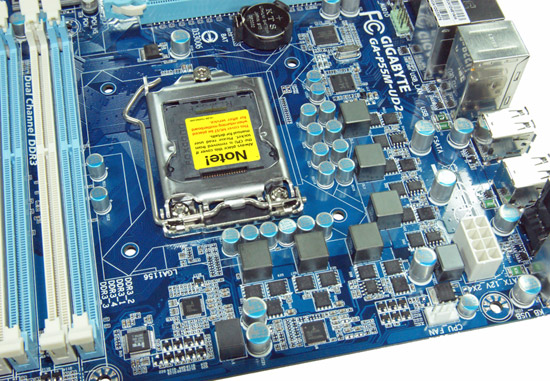
Gigabyte utilizes a solid six-phase PWM setup on this board. The CPU area is open for the most part and will accommodate larger coolers like the Thermalright MUX 120. Large push/pull coolers like the Vigor Monsoon III LT will block the first DIMM slot. If you plan on running this board with Bclk rates above 170 or so, we suggest additional airflow across the MOSFETs to ensure 24/7 stability when overclocking.
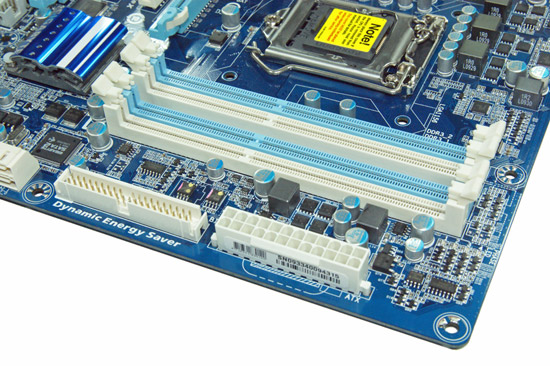
The IDE port, 24-pin ATX power connector, and the four DIMM slots are located in the lower right hand corner of the board. This board supports dual channel memory configurations and 16GB of DDR3 memory when using 4GB DIMMS. Installing the memory with a video card inserted in the first slot is difficult but not impossible.
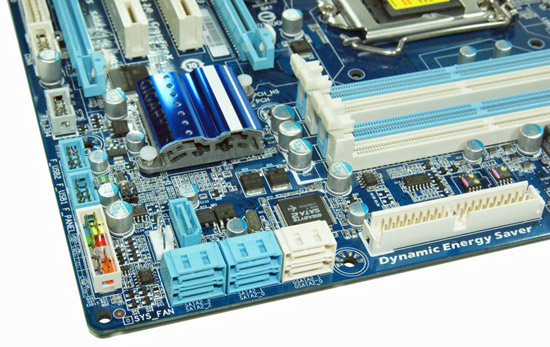
There are five (blue) SATA 3Gb/s ports provided by the P55 chipset that support RAID 0, 1, 5, 10. The sixth port available on the P55 (under the blue heatsink) is utilized on the I/O panel for eSATA. Gigabyte includes the JMicron JMB363 3Gb/s SATA chip that drives the two white SATA ports and provides IDE support. The front panel header, two USB headers, and the IEEE 1394a header are located at the edge of the board.
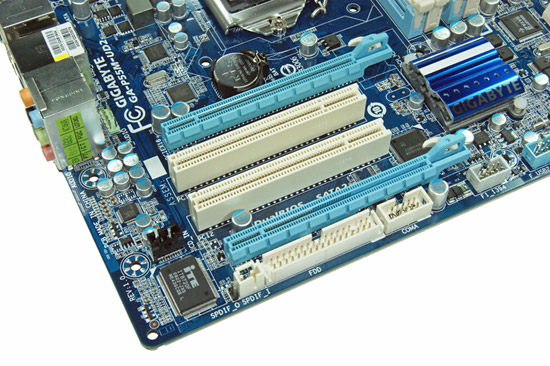
Gigabyte includes two PCIe x16 slots (x16 operation for the first slot, x4 operation for the second slot) and two PCI slots. The first PCI slot will be unavailable when utilizing a dual slot video card.
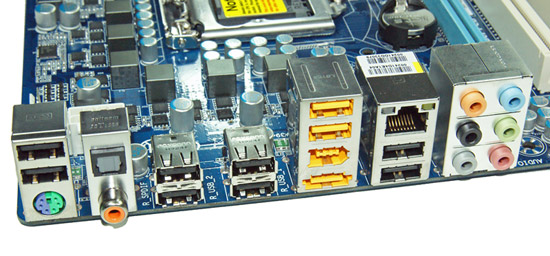
Last but not least is the I/O panel. We have ten USB 2.0 ports (total of fourteen on the board), combination PS/2 port, single eSATA port, IEEE 1394a port offered by the TI TSB43AB23 chipset, Gigabit Ethernet LAN port via the Realtek RTL8111D chipset, optical out/coaxial out S/PDIF ports, and the audio panel that provides 8-channel audio output via the Realtek ALC 888B HD audio codec.
BIOS Information
Apparently this preview did not have enough substance in it according to a few reader comments. I totally agree. However, I will state this one more time, we are bound by an NDA and cannot provide that substance for another week or so. That said, we can now show the general layout of the BIOS, thus providing a little more substance than we had yesterday. I will leave it at that for now.

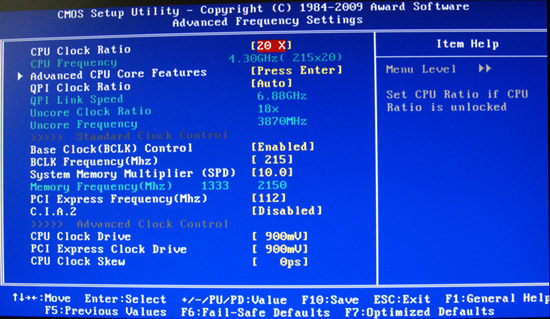
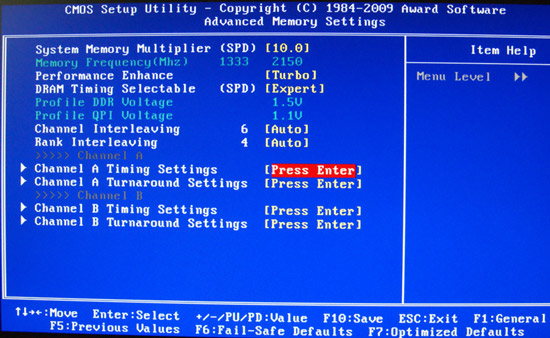


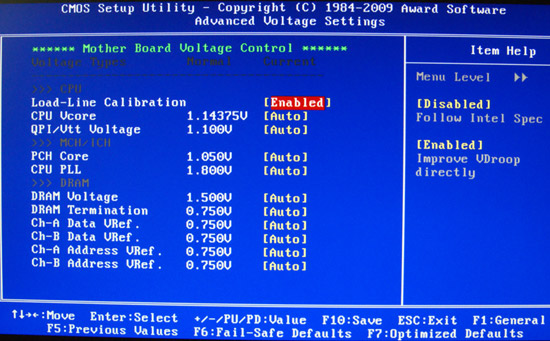






















76 Comments
View All Comments
TA152H - Saturday, August 29, 2009 - link
He is a moron, and he has a right to know. Also, we don't need him breeding, not that a woman would be interested anyway. But, you never know. Desperation never made a good choice.With regards to the i5, you're missing some very important possibilities. You realize you need pins on the processor to handle this, right? Based on the number of pins they removed, where do these come from?
Also, your assessment of the on-die PCI-E is completely off. Memory is fast enough to benefit from the device being on-die, and you're transporting from memory to the processor. PCI-Express is different. It's much slower than memory, and it's generally not going to the processor, but through it to memory, or another device. It's not at all the same.
Unless they have pins specifically for this, which is doubtful given the reduction, but still possible, they have to multiplex the pins. At any rate, now the processor can have contention between handling the memory bus, and the PCI stuff on it.
It's possible Intel has seperate pins, and each section works perfectly independently. But, I doubt it given the pin reduction. I guess we'll see.
But, it won't be faster because most devices attached to PCI-E are REALLY slow compared to the processor. GPUs normally don't need to send much data to the processor, but work mostly with memory, and typically bypass the processor to do this. Now they can't. This could bring up contention issues. We'll have to see the implementation. Of course, they could have given us detailed information on this site of the pinouts, unless Intel said they couldn't with the NDA, but they haven't. We got pictures of some motherboards.
Etern205 - Tuesday, September 1, 2009 - link
Not only that he's the one who also complained about a recent poll as to why "Core i7" wasn't in one of the choices.Very childlish like for a person to have "actually" written a article.
Anandtech, would you please ban that person since he's nothing but a troll. I just hope the people who wants to learn about computers isn't brainwashed by he's uninformative bs and well as his stupidity.
For those who are trying to learn, seriously do not read of of that person's articles or listen to what that idiot says!
PassingBy - Monday, August 31, 2009 - link
'Pin multiplexing' between the PCIe and DDR3 interfaces is good for nothing more than a laff on a Monday morning.ClagMaster - Saturday, August 29, 2009 - link
Interesting theory -- about the on-die PCI-E controller and memory contentions. You may have a point there. Before, the PCI-E and system memory were handled by the Northbridge and PCI-E to memory transfers were handled locally.I do not know what the on-die memory bus bandwidth is on i5 and i7. If a third memory channel were removed and assuming on-die memory bus remained the same, there would be about 1/3 excess capacity on this bus since only two memory channels are active. This allowed Intel to remove pins from the LGA1366 to LGA1156 (381 pins) for the missing memory channel and removed QPI less any needed for the PCI-E link and DMI.
I am certain neccesary dedicated pins are present for two independent memory channels. The removed third DDR3 channel is 240 pins. That leaves 141 pins unaccounted for which is the source of your contention? These unaccounted pins most likely came from QPI that was removed from the LGA1156 socket -- less the pins needed for the slower DMX and the PCI-E direct link.
Yes, we will have to wait and see the i5/P55 benchmarks compared to C2Q/P45 when they are finally published. The memory benchmarks in particular would be telling if you are correct that there is contention between PCI-E and the regular memory system on the internal bus.
Penti - Sunday, September 6, 2009 - link
It's kinda retarded argument, the memory controller, NB logic and PCI-e on-die controller are all separate logic with there own transistors and are not using the cpus executing engine or something like that. It won't get worse just because you move these blocks to the CPU, and obviously it works fine with having on-die memory controller and PCI-e on the NB with i7 and AMD.philosofool - Saturday, August 29, 2009 - link
I have two of the three billy goats gruff and a big bag of troll snacks if you want to come over to my house and play.TA152H - Saturday, August 29, 2009 - link
You probably have weird diseases, no thanks.ClagMaster - Saturday, August 29, 2009 - link
No CDC-7600? Shame on you!!!tacoburrito - Friday, August 28, 2009 - link
I have to agree with the uselessness of the article except I wouldn't sound quite as harsh. I fail to see the point of learning about MBs that will play host to a processor that won't be out for another month. Even then, learning about the i5 will be more informative than the MB itself. It's almost like getting excited over a new iphone battery that lasts for 1000 hours without charging but this battery will only be used on the sixth generation iphone out in 2015.anandreader - Saturday, August 29, 2009 - link
Well not quite 2015. September 6, 2009 seems to be the drop date. I was mucking around trying to find performance data and stumbled across this motherboard manualhttp://europe.giga-byte.com/FileList/Manual/mb_mau...">http://europe.giga-byte.com/FileList/Manual/mb_mau...
The overclocking utility that Gigabyte ships with their boards managed 3.37 gHz.
These reviews are of interest to folks such as me who would have bought an i7 setup a couple of months ago except these "reviews" started dropping and one of the Anand writers implied that the p55-based CPUs were going to be worth waiting for. So if I'm at all typical, there's some pent-up demand waiting for the drop and subsequent reviews.
If I had seen a board that had rootkit protection for the Bios, I'd know which board I was going to get when the drop hit but failing that, I'll wait and see. This Gigabyte board, though nice, appears to be too easy to infect.